Chen Zhang
SenseTime Research
A Survey on LLM Mid-training
Oct 27, 2025Abstract:Recent advances in foundation models have highlighted the significant benefits of multi-stage training, with a particular emphasis on the emergence of mid-training as a vital stage that bridges pre-training and post-training. Mid-training is distinguished by its use of intermediate data and computational resources, systematically enhancing specified capabilities such as mathematics, coding, reasoning, and long-context extension, while maintaining foundational competencies. This survey provides a formal definition of mid-training for large language models (LLMs) and investigates optimization frameworks that encompass data curation, training strategies, and model architecture optimization. We analyze mainstream model implementations in the context of objective-driven interventions, illustrating how mid-training serves as a distinct and critical stage in the progressive development of LLM capabilities. By clarifying the unique contributions of mid-training, this survey offers a comprehensive taxonomy and actionable insights, supporting future research and innovation in the advancement of LLMs.
Doc-Researcher: A Unified System for Multimodal Document Parsing and Deep Research
Oct 24, 2025Abstract:Deep Research systems have revolutionized how LLMs solve complex questions through iterative reasoning and evidence gathering. However, current systems remain fundamentally constrained to textual web data, overlooking the vast knowledge embedded in multimodal documents Processing such documents demands sophisticated parsing to preserve visual semantics (figures, tables, charts, and equations), intelligent chunking to maintain structural coherence, and adaptive retrieval across modalities, which are capabilities absent in existing systems. In response, we present Doc-Researcher, a unified system that bridges this gap through three integrated components: (i) deep multimodal parsing that preserves layout structure and visual semantics while creating multi-granular representations from chunk to document level, (ii) systematic retrieval architecture supporting text-only, vision-only, and hybrid paradigms with dynamic granularity selection, and (iii) iterative multi-agent workflows that decompose complex queries, progressively accumulate evidence, and synthesize comprehensive answers across documents and modalities. To enable rigorous evaluation, we introduce M4DocBench, the first benchmark for Multi-modal, Multi-hop, Multi-document, and Multi-turn deep research. Featuring 158 expert-annotated questions with complete evidence chains across 304 documents, M4DocBench tests capabilities that existing benchmarks cannot assess. Experiments demonstrate that Doc-Researcher achieves 50.6% accuracy, 3.4xbetter than state-of-the-art baselines, validating that effective document research requires not just better retrieval, but fundamentally deep parsing that preserve multimodal integrity and support iterative research. Our work establishes a new paradigm for conducting deep research on multimodal document collections.
MG2FlowNet: Accelerating High-Reward Sample Generation via Enhanced MCTS and Greediness Control
Oct 01, 2025



Abstract:Generative Flow Networks (GFlowNets) have emerged as a powerful tool for generating diverse and high-reward structured objects by learning to sample from a distribution proportional to a given reward function. Unlike conventional reinforcement learning (RL) approaches that prioritize optimization of a single trajectory, GFlowNets seek to balance diversity and reward by modeling the entire trajectory distribution. This capability makes them especially suitable for domains such as molecular design and combinatorial optimization. However, existing GFlowNets sampling strategies tend to overexplore and struggle to consistently generate high-reward samples, particularly in large search spaces with sparse high-reward regions. Therefore, improving the probability of generating high-reward samples without sacrificing diversity remains a key challenge under this premise. In this work, we integrate an enhanced Monte Carlo Tree Search (MCTS) into the GFlowNets sampling process, using MCTS-based policy evaluation to guide the generation toward high-reward trajectories and Polynomial Upper Confidence Trees (PUCT) to balance exploration and exploitation adaptively, and we introduce a controllable mechanism to regulate the degree of greediness. Our method enhances exploitation without sacrificing diversity by dynamically balancing exploration and reward-driven guidance. The experimental results show that our method can not only accelerate the speed of discovering high-reward regions but also continuously generate high-reward samples, while preserving the diversity of the generative distribution. All implementations are available at https://github.com/ZRNB/MG2FlowNet.
FAME: Adaptive Functional Attention with Expert Routing for Function-on-Function Regression
Oct 01, 2025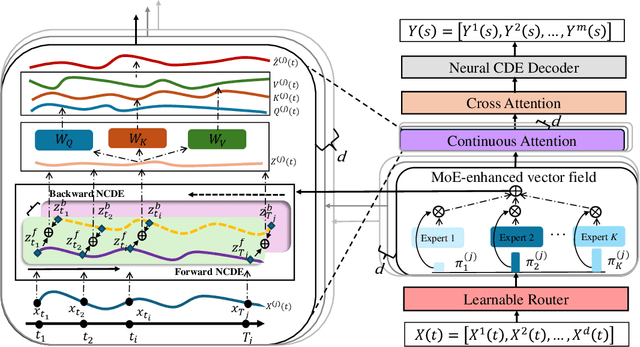
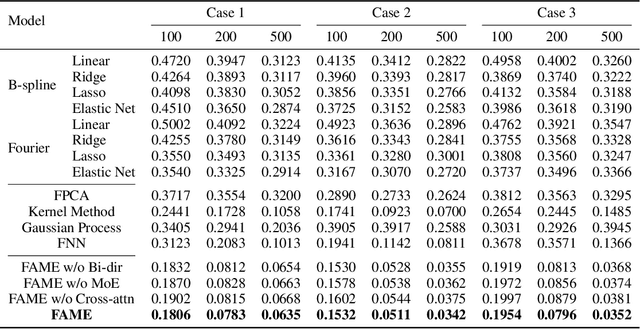

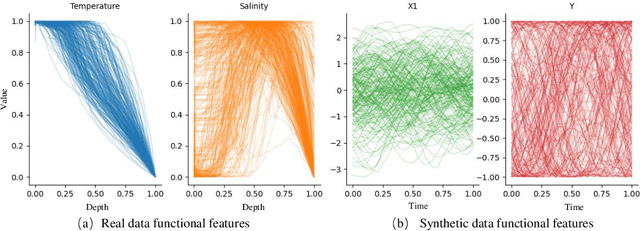
Abstract:Functional data play a pivotal role across science and engineering, yet their infinite-dimensional nature makes representation learning challenging. Conventional statistical models depend on pre-chosen basis expansions or kernels, limiting the flexibility of data-driven discovery, while many deep-learning pipelines treat functions as fixed-grid vectors, ignoring inherent continuity. In this paper, we introduce Functional Attention with a Mixture-of-Experts (FAME), an end-to-end, fully data-driven framework for function-on-function regression. FAME forms continuous attention by coupling a bidirectional neural controlled differential equation with MoE-driven vector fields to capture intra-functional continuity, and further fuses change to inter-functional dependencies via multi-head cross attention. Extensive experiments on synthetic and real-world functional-regression benchmarks show that FAME achieves state-of-the-art accuracy, strong robustness to arbitrarily sampled discrete observations of functions.
ClusterFusion: Expanding Operator Fusion Scope for LLM Inference via Cluster-Level Collective Primitive
Aug 26, 2025

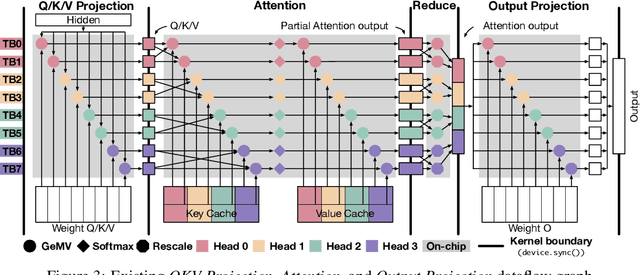

Abstract:Large language model (LLM) decoding suffers from high latency due to fragmented execution across operators and heavy reliance on off-chip memory for data exchange and reduction. This execution model limits opportunities for fusion and incurs significant memory traffic and kernel launch overhead. While modern architectures such as NVIDIA Hopper provide distributed shared memory and low-latency intra-cluster interconnects, they expose only low-level data movement instructions, lacking structured abstractions for collective on-chip communication. To bridge this software-hardware gap, we introduce two cluster-level communication primitives, ClusterReduce and ClusterGather, which abstract common communication patterns and enable structured, high-speed data exchange and reduction between thread blocks within a cluster, allowing intermediate results to be on-chip without involving off-chip memory. Building on these abstractions, we design ClusterFusion, an execution framework that schedules communication and computation jointly to expand operator fusion scope by composing decoding stages such as QKV Projection, Attention, and Output Projection into a single fused kernels. Evaluations on H100 GPUs show that ClusterFusion outperforms state-of-the-art inference frameworks by 1.61x on average in end-to-end latency across different models and configurations. The source code is available at https://github.com/xinhao-luo/ClusterFusion.
Few-shot Unknown Class Discovery of Hyperspectral Images with Prototype Learning and Clustering
Aug 25, 2025Abstract:Open-set few-shot hyperspectral image (HSI) classification aims to classify image pixels by using few labeled pixels per class, where the pixels to be classified may be not all from the classes that have been seen. To address the open-set HSI classification challenge, current methods focus mainly on distinguishing the unknown class samples from the known class samples and rejecting them to increase the accuracy of identifying known class samples. They fails to further identify or discovery the unknow classes among the samples. This paper proposes a prototype learning and clustering method for discoverying unknown classes in HSIs under the few-shot environment. Using few labeled samples, it strives to develop the ability of infering the prototypes of unknown classes while distinguishing unknown classes from known classes. Once the unknown class samples are rejected by the learned known class classifier, the proposed method can further cluster the unknown class samples into different classes according to their distance to the inferred unknown class prototypes. Compared to existing state-of-the-art methods, extensive experiments on four benchmark HSI datasets demonstrate that our proposed method exhibits competitive performance in open-set few-shot HSI classification tasks. All the codes are available at \href{https://github.com/KOBEN-ff/OpenFUCD-main} {https://github.com/KOBEN-ff/OpenFUCD-main}
ZigzagAttention: Efficient Long-Context Inference with Exclusive Retrieval and Streaming Heads
Aug 17, 2025Abstract:With the rapid development of large language models (LLMs), handling long context has become one of the vital abilities in LLMs. Such long-context ability is accompanied by difficulties in deployment, especially due to the increased consumption of KV cache. There is certain work aiming to optimize the memory footprint of KV cache, inspired by the observation that attention heads can be categorized into retrieval heads that are of great significance and streaming heads that are of less significance. Typically, identifying the streaming heads and and waiving the KV cache in the streaming heads would largely reduce the overhead without hurting the performance that much. However, since employing both retrieval and streaming heads in one layer decomposes one large round of attention computation into two small ones, it may unexpectedly bring extra latency on accessing and indexing tensors. Based on this intuition, we impose an important improvement to the identification process of retrieval and streaming heads, in which we design a criterion that enforces exclusively retrieval or streaming heads gathered in one unique layer. In this way, we further eliminate the extra latency and only incur negligible performance degradation. Our method named \textsc{ZigzagAttention} is competitive among considered baselines owing to reduced latency and comparable performance.
AudioGen-Omni: A Unified Multimodal Diffusion Transformer for Video-Synchronized Audio, Speech, and Song Generation
Aug 01, 2025Abstract:We present AudioGen-Omni - a unified approach based on multimodal diffusion transformers (MMDit), capable of generating high-fidelity audio, speech, and songs coherently synchronized with the input video. AudioGen-Omni introduces a novel joint training paradigm that seamlessly integrates large-scale video-text-audio corpora, enabling a model capable of generating semantically rich, acoustically diverse audio conditioned on multimodal inputs and adaptable to a wide range of audio generation tasks. AudioGen-Omni employs a unified lyrics-transcription encoder that encodes graphemes and phonemes from both sung and spoken inputs into dense frame-level representations. Dense frame-level representations are fused using an AdaLN-based joint attention mechanism enhanced with phase-aligned anisotropic positional infusion (PAAPI), wherein RoPE is selectively applied to temporally structured modalities to ensure precise and robust cross-modal alignment. By unfreezing all modalities and masking missing inputs, AudioGen-Omni mitigates the semantic constraints of text-frozen paradigms, enabling effective cross-modal conditioning. This joint training approach enhances audio quality, semantic alignment, and lip-sync accuracy, while also achieving state-of-the-art results on Text-to-Audio/Speech/Song tasks. With an inference time of 1.91 seconds for 8 seconds of audio, it offers substantial improvements in both efficiency and generality.
Hypernetworks for Model-Heterogeneous Personalized Federated Learning
Jul 30, 2025
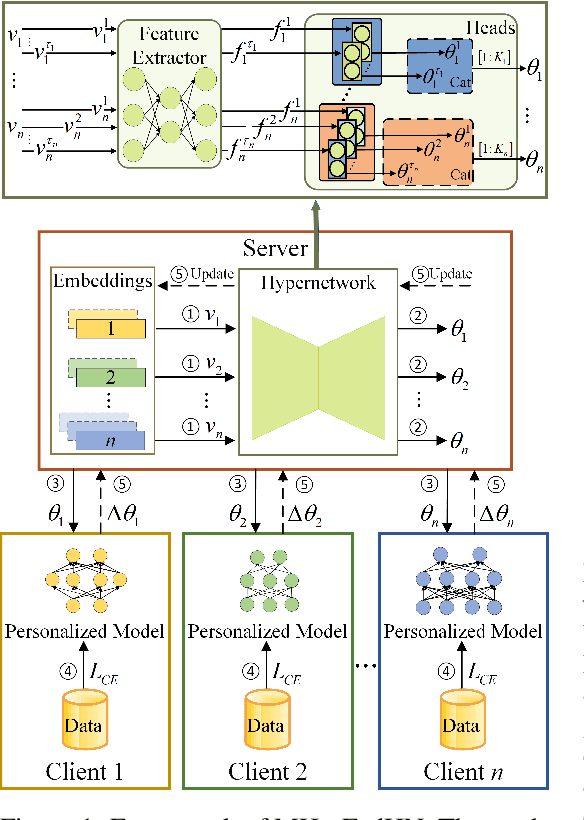


Abstract:Recent advances in personalized federated learning have focused on addressing client model heterogeneity. However, most existing methods still require external data, rely on model decoupling, or adopt partial learning strategies, which can limit their practicality and scalability. In this paper, we revisit hypernetwork-based methods and leverage their strong generalization capabilities to design a simple yet effective framework for heterogeneous personalized federated learning. Specifically, we propose MH-pFedHN, which leverages a server-side hypernetwork that takes client-specific embedding vectors as input and outputs personalized parameters tailored to each client's heterogeneous model. To promote knowledge sharing and reduce computation, we introduce a multi-head structure within the hypernetwork, allowing clients with similar model sizes to share heads. Furthermore, we further propose MH-pFedHNGD, which integrates an optional lightweight global model to improve generalization. Our framework does not rely on external datasets and does not require disclosure of client model architectures, thereby offering enhanced privacy and flexibility. Extensive experiments on multiple benchmarks and model settings demonstrate that our approach achieves competitive accuracy, strong generalization, and serves as a robust baseline for future research in model-heterogeneous personalized federated learning.
AC-Refiner: Efficient Arithmetic Circuit Optimization Using Conditional Diffusion Models
Jul 03, 2025Abstract:Arithmetic circuits, such as adders and multipliers, are fundamental components of digital systems, directly impacting the performance, power efficiency, and area footprint. However, optimizing these circuits remains challenging due to the vast design space and complex physical constraints. While recent deep learning-based approaches have shown promise, they struggle to consistently explore high-potential design variants, limiting their optimization efficiency. To address this challenge, we propose AC-Refiner, a novel arithmetic circuit optimization framework leveraging conditional diffusion models. Our key insight is to reframe arithmetic circuit synthesis as a conditional image generation task. By carefully conditioning the denoising diffusion process on target quality-of-results (QoRs), AC-Refiner consistently produces high-quality circuit designs. Furthermore, the explored designs are used to fine-tune the diffusion model, which focuses the exploration near the Pareto frontier. Experimental results demonstrate that AC-Refiner generates designs with superior Pareto optimality, outperforming state-of-the-art baselines. The performance gain is further validated by integrating AC-Refiner into practical applications.
 Add to Chrome
Add to Chrome Add to Firefox
Add to Firefox Add to Edge
Add to Edge